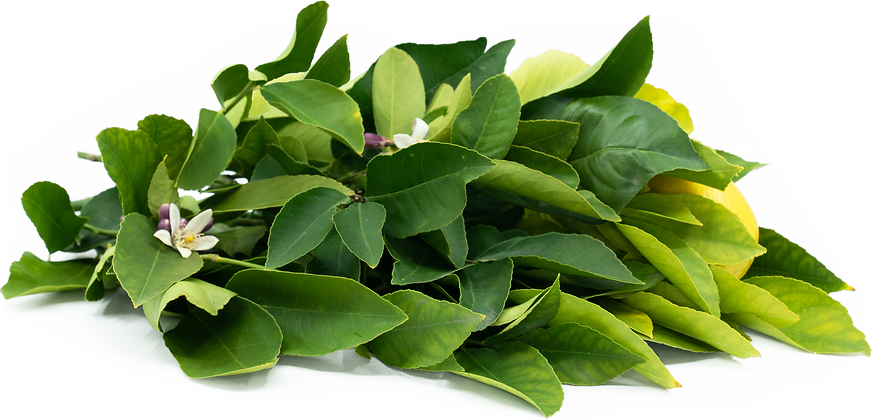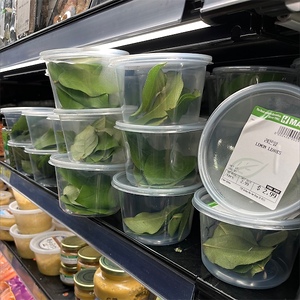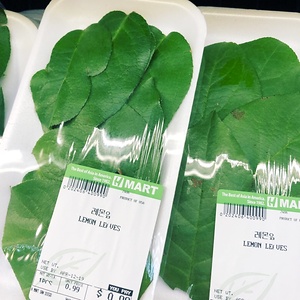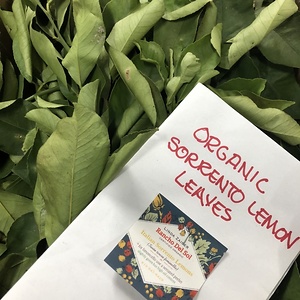


Lemon Leaves
Estimated Inventory, bunch : 3.00
This item was last sold on : 06/28/25
Description/Taste
Lemon leaves are small to medium in size and are ovate, oblong, and taper to a point on the non-stem end. The vibrant green leaves grow alternately along the branches, and they have fine-toothed edges with a slight rippling. There is also a prominent central stem with some small veins spreading throughout the leaf. Lemon leaves have a glossy finish on the green topside and a matte finish on their lighter green underside. When young, Lemon leaves are red and as they mature turn to a deep green. Lemon leaves are slightly oily with an aromatic and bright, green, citrus taste.
Seasons/Availability
Lemon leaves are available year-round.
Current Facts
Lemon leaves, botanically classified as Citrus limon, grow on a thorny tree that can reach up to six meters in height and are members of the Rutaceae, or citrus family. Also known as Limone, Limón, Limón agria, Limón real, and Limón francés, lemon trees are grown in warm, tropical and semi-tropical climates and are commercially cultivated for their fruit. Lemon leaves are a secondary crop utilized in many cultures throughout the world for flavoring dishes, making teas, and as an aromatic decoration.
Nutritional Value
Lemon leaves, when boiled to make teas, may have antispasmodic and sedative properties.
Applications
Lemon leaves are not consumed and are best suited for cooking applications such as grilling or sautéing. They can be used fresh for their aromatics, which is their singular culinary attribute. Lemon leaves can be wrapped around seafood and meats and can be roasted, steamed, or grilled. They can also be used to flavor kabobs, used in curries, and blanched and used to infuse tea. Lemon leaves can be used as a garnish for desserts such as lemon cakes and they can also be used as a mold to make chocolate leaves. Lemon leaves pair well with fresh seafood, oysters, fresh anchovy fillets, pork, chicken, mint, parsley, basil, garlic, olive oil, vinegar, and chopped pistachios. They will keep for 1-2 days when stored fresh in the refrigerator. They can also be dried for extended use.
Ethnic/Cultural Info
The south of Italy is known for its lemon trees, and Lemon leaves are prominently used in cooking to impart bright flavors. On the island of Sicily, they make the well-known dish polpette, which are meatballs wrapped in lemon leaves and baked. Along the Amalfi coast, scamorza affumicata, or smoked mozzarella is grilled between lemon leaves to create a fragrant, soft, and oozing cheese and served as an appetizer or side dish. In addition to culinary applications, Lemon leaves are also used to make garlands, bridal bouquets, and wreaths as the leaves add a light, citrus fragrance and are very aromatic.
Geography/History
The lemon tree's origins are traced back to northern India, where lemon trees are still found growing wild. Lemons were then transported and eventually cultivated in Africa and Europe and were first introduced in America in the early 1500s. Today, Lemon leaves can be found in fresh markets in select regions in the United States, South America, Africa, Europe, Asia, and Australia.
Featured Restaurants
Restaurants currently purchasing this product as an ingredient for their menu.
| Happy Medium SD (bar) | San Diego CA | 509-869-2279 |
Recipe Ideas
Recipes that include Lemon Leaves. One
| Emiko Davies |
|
Oysters Wrapped in Lemon Leaves |
| Bawarchi |
|
Lemon Leaf Mint Thogayal |











